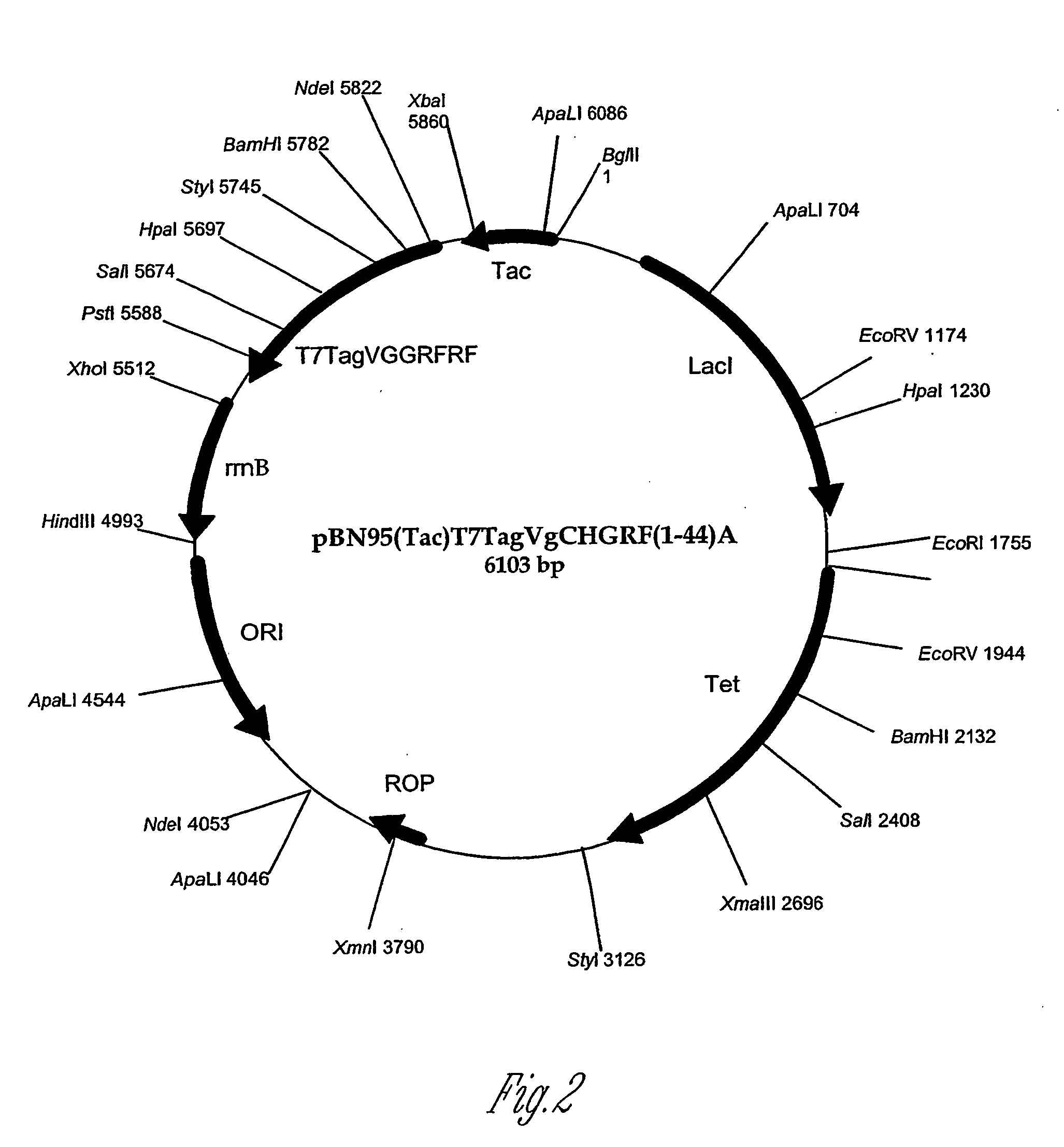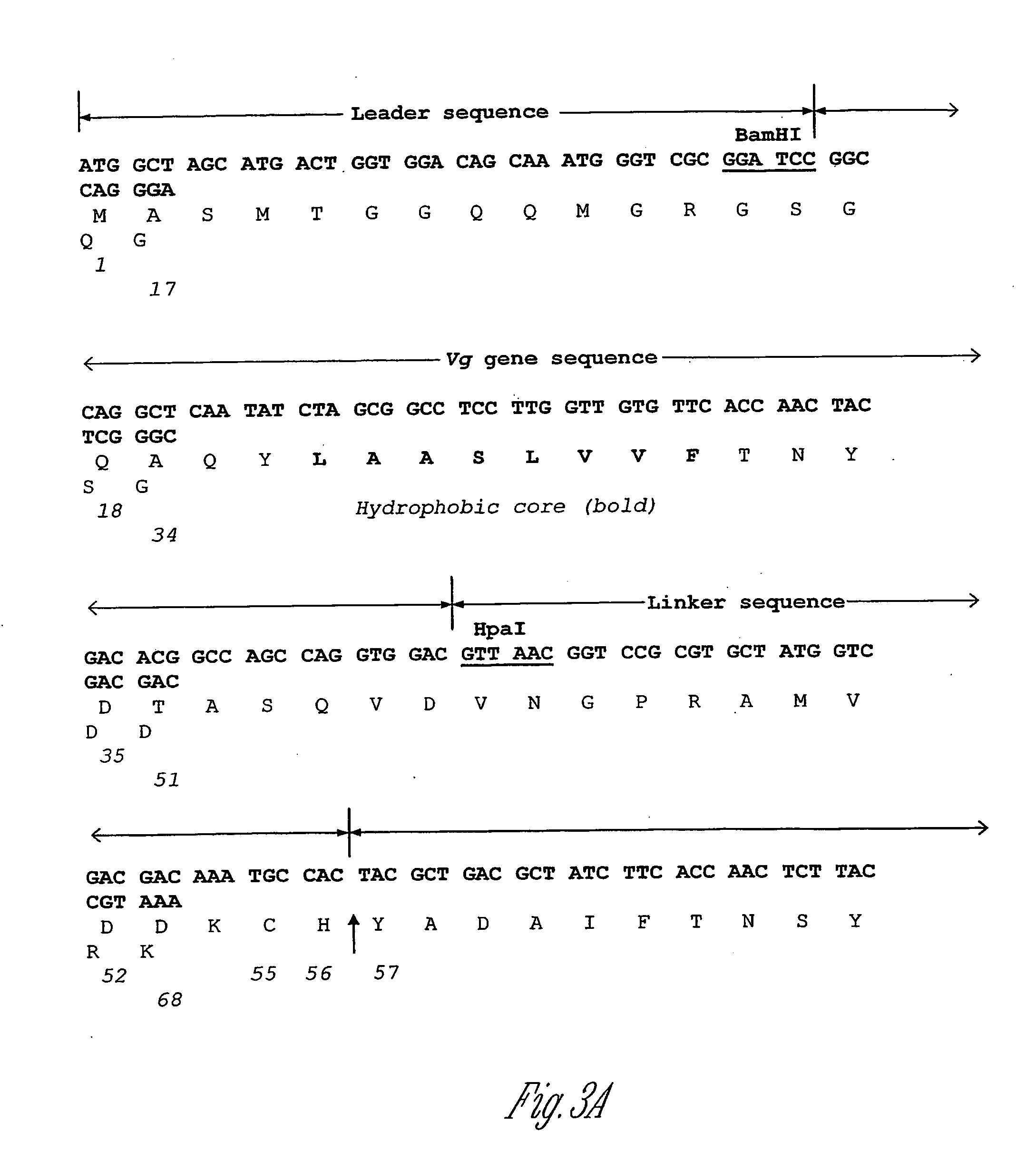Methods and DNA constructs for high yield production of polypeptides
a polypeptide and high-yield technology, applied in the field of protein expression, can solve the problems of decreased production efficiency, less availability of therapeutically useful polypeptides, and difficulty in expressing proteins and peptides in cells, and achieve the effect of increasing ease and controllable solubility
- Summary
- Abstract
- Description
- Claims
- Application Information
AI Technical Summary
Benefits of technology
Problems solved by technology
Method used
Image
Examples
example 1
Construction of a pBN95(Tac) Vector
[0183] pBN95(Tac) is an optimized expression vector containing the backbone, origin of replication, and the tetracycline resistance gene from the pBR322 plasmid (New England Biolab, Beverly, Mass.); the lacI gene (encoding a repressor protein) from pET16b (Novagen, Madison, Wis.); the tac promoter from pGEX2T (Amersham Pharmacia Biotech, Piscataway, N.J.); and the rrnB termination sequence from pKK223-3 (Amersham Pharmacia Biotech). The plasmid was constructed as described below.
[0184] The pBR322 vector backbone was prepared by cleaving the pBR322 plasmid (New England Biolabs, Beverly, Mass.) with PstI-SspI and isolating the large (approximately 3.5 kb) backbone fragment from an agarose gel. The lacI gene was excised from the pET16b vector (Novagen) by cleavage with PstI, SapI and PshAI. The larger of the three released fragments (2.8 kb, compared to 1.2 kb and 1.7 kb) was isolated from an agarose gel. The lacI containing fragment was mixed with ...
example 2
Construction of the pET23a-T7tagVg-GRF(1-44)A Plasmid, the pBN95(Tac)-T7tagVgCH-GRF(1-44)A Plasmid, and the pBN95-T7tagVgCH-GRF-(1-44)A Plasmid
[0191] Polypeptide production by different E. coli strains (e.g., K strain or B strain) was developed through use of expression vectors containing different promoters (e.g., tac or T7) and different antibiotic selections (e.g., tetracycline or ampicillin). The expression vector pET23a (Novagen) has the T7 promoter and the ampicillin resistance gene. The expression vector pBN95(Tac) has the tac promoter and the tetracycline resistance gene. Expression vectors were constructed to contain the gene sequences for the following: (a) 12 amino acids of the T7tag (MASMTGGQQMGR) (SEQ ID NO: 83); (b) 29 amino acids of the vestigial (Vg) peptide (GSGQGQAQYL AASLVVFTNY SGDTA SQVD) (SEQ ID NO: 2) (Williams et al., Genes &Development, 5:2481, 1991); (c) an amino acid linker (VNGPR AMVDD DDKCH) (SEQ ID NO: 146); and (d) the target peptide of GRF(1-44)A The ...
example 3
E. coli Shaking Culture Expression of Polypeptides Containing GRF(1-44)A
[0202] To express polypeptides, E. coli BL21 was the host cell when using tac promoter while BL21(DE3) was the host cell when using T7 promoter (Both cells are from Novagen, Madison, Wis.). Plasmids of the pET23a-T7tag-GRF(1-44)A, pET23a-T7tagVg-GRF(1-44)A, pET23a-T7tagVgCH-GRF(1-44)A and pBN95(Tac)-T7tagVgCH-GRF(1-44)A were transformed into CaCl2-treated competent cells by heat shock at 42° C. for 45 seconds. Transformed cells were selected on LB+50 μg / mL ampicillin (LBA)+agar plates for pET23a constructs, or on LB+15 μg / mL tetracycline (LBT) media+agar plates for pBN95(tac) constructs. Shaking flask cultures of 5 ml LBA or LBT media were started from single colonies of the transformed cells. Late log phase or overnight cell cultures were preserved in 10-15% glycerol at −80° C. or below (glycerol stocks). Shaking flask cultures in 5 ml to 500 ml LBA or LBT media (inoculated by 100 ul to 10 ml overnight culture...
PUM
| Property | Measurement | Unit |
|---|---|---|
| time | aaaaa | aaaaa |
| pH | aaaaa | aaaaa |
| temperature | aaaaa | aaaaa |
Abstract
Description
Claims
Application Information
 Login to View More
Login to View More - R&D
- Intellectual Property
- Life Sciences
- Materials
- Tech Scout
- Unparalleled Data Quality
- Higher Quality Content
- 60% Fewer Hallucinations
Browse by: Latest US Patents, China's latest patents, Technical Efficacy Thesaurus, Application Domain, Technology Topic, Popular Technical Reports.
© 2025 PatSnap. All rights reserved.Legal|Privacy policy|Modern Slavery Act Transparency Statement|Sitemap|About US| Contact US: help@patsnap.com



